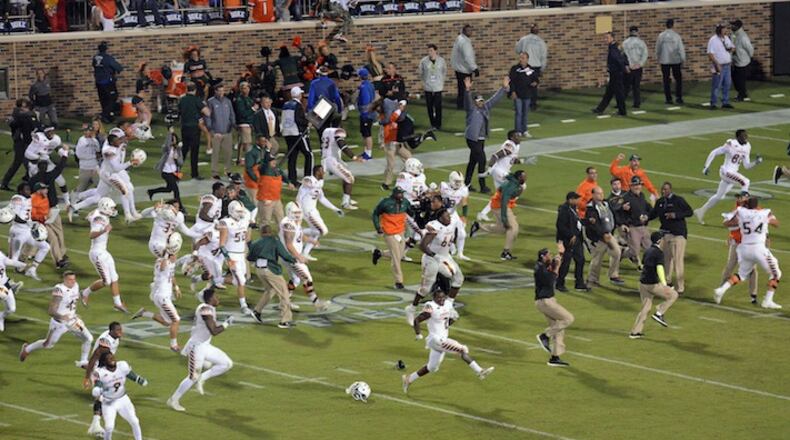By now, the eight-lateral kick return for Miami's winning touchdown over Duke has joined California's storied five-lateral "Play To Beat The Band" against Stanford in 1982 in college football lore.
Is there actually a way to prepare plays like that?
Coaches say end-of-the-game plays can be drawn up and practiced, but the preparation really doesn't mean much in the heat of the moment. Think of it more like organized chaos.
"At some point, it's all hell broke loose, and someone's got to run out there and make a play," Tennessee special teams coach Mark Elder said. "You have your initial plan on what you're doing, but at some point that thing turns into backyard football like when you're 10 years old and you're tossing the ball around."
The consensus from interviews with coaches this week was that teams devote time in preseason practice — and a little bit of time every one or two weeks during the season — to working on how to run and defend plays like Miami's appropriately named "Desperado."
"You can practice it, but you can't do it organized," Florida State coach Jimbo Fisher said. "That's instinct and intuition as you go."
Simple principles are emphasized.
On the return team, there might be a six-man front, with three blockers on each side. The other five players spread out and trail the man with the ball, giving him options for throwbacks and laterals. Ideally, the ball carrier should lateral before getting hit — to avoid having a knee touch the ground — and to ensure accuracy of the pitch. The play flows toward open field until a tackle is made or a running lane opens.
The kick coverage team generally is coached to have four interior players chase the ball while the rest stay disciplined and make sure the play doesn't break to the outside.
"It's never the same play twice," Nebraska special teams coordinator Bruce Read said. "It's very ad lib. So you're never really able to simulate what's going to happen."
The chance of success for the return team?
"It's a divine intervention when that stuff happens," Oklahoma special teams coordinator Jay Boulware said. "I don't care how much you execute it, how well you think you executed it in practice, until you get into a live situation with live guys trying to tackle you, you really never know how those plays are going to unfold and what's going to happen."
Specific players are assigned to the last-gasp kick return teams, much like the receivers and defensive backs who make up the so-called "hands" team that fields onside kicks.
"There's a lot of ball-handlers on there," Boulware said.
As amazing as it was, Miami's 75-yard touchdown that Corn Elder finished against Duke should not have counted. The ACC confirmed what many people saw Saturday: a Miami player's knee was down as he threw one of the laterals, and officials missed a block in the back.
Illegal blocks are a risk — and a point of emphasis in coaching defenders — because bodies are turning every which way as the play changes directions.
"Stay penalty free," Arkansas coach Bret Bielema said, "because it could all go for naught if something like that goes through."
Alabama coach Nick Saban said the Miami-Duke game provided a teachable moment, just like Michigan State's scoop-and-score to beat Michigan a few weeks ago.
"Your goal as a coach is to sort of prepare your team for every scenario, every situation that could ever happen in a game," he said. "I think these crazy-finish games all had sort of a scenario at the end of the game that was obviously the critical factor that made the difference in the game. I think that any time you see this happen — sometimes it happens in the NFL — you bring it to your players' attention about how important this play is, how important it is to finish or do it correctly."
About the Author
Keep Reading
The Latest
Featured


